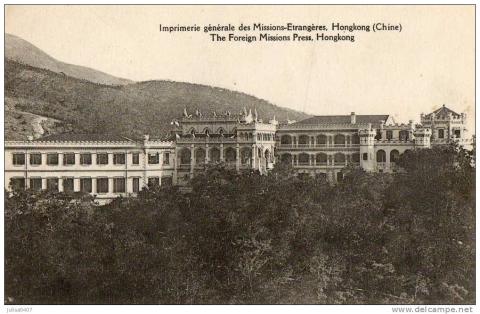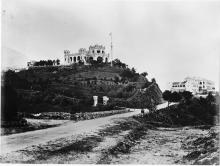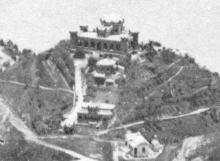1863 - Douglas Castle built by Douglas Lapraik, a watchmaker who expanded into shipping. He returned to England almost as soon as Douglas Castle was built, and died about 5 years later.
His nephew, John Steward Lapraik inherited the business and over the next 30 years made it phenomomally sucessful. His residence was listed as Douglas Castle. After he died, age 54, it was sold.
1894 - Bought by the French Mission - who built a new wing, chapel and printing house to the north-east of the castle.
In the early 20th century, it was rebuilt, and of the original Douglas Castle, only two side towers and six steps remain to this day

1954 - Bought by HKU
The existing partitions were simply furnished with beds, wardrobes, desks and other furniture, the chapel was converted into a dining hall and the crypt below it became a common room - and in 1956 University Hall residence for male students was born.
more at ... http://www.uhall.com.hk/portal/aboutUhall/TheCastle.php
Extracted from the University Hall 50th Anniversary commemorative book published by University Hall Alumni Ltd. in 2007.
Click here for a copy
nice slide show at http://www3.hku.hk/uhall/




Comments
La Maison de Nazareth,
La Maison de Nazareth, one of the establishments of the Societe" des Missions-Etrangeres founded, at Paris in the year 1660, occupies the much enlarged premises of the Old Douglas Castle at Pokfolum. The great, and very important work undertaken bv this Society is Evangelistic training and Religious instruction amongst the various nations of the Far East, and throughout every province of the Chinese Empire. In the execution of this work, the establishment operates a type foundry and an extensive printing office where books are published in most of the Asiatic languages, and sometimes is hitherto unknown tongues. The Mission even goes so far as to invent, design, and establish characters for written language where, as is occasionally discovered, no such alphabetical system has ever before existed.
This useful and Model institution at Pokfolum, is unique in every respect, and in doing the afternoon walk from the Peak (Programme No. 1) half-an-hour may be very pleasantly spent in seeing over the place; The many branches of the Mission-Etrangeres and the object, and extent of their labours are perhaps the widest of any of the Foreign Missions in this part of the world. The French Fathers have always a hearty welcome for everyone
Source: The Tourist's Guide to Hong Kong, with short trips to the Mainland of China … (1897) by HURLEY, R. C.
.
Source: Old Hong Kong by Colonial Vol 1
In May 1894 Douglas Castle was purchased for use a a printery
The house was indeed a " castle’ Of English type, designed according to the Tudor style, it had an imposing appearance with its angle turrets, battlements, and embrasures. The architect entrusted with the work of enlarging it had deemed it due to his professional reputation to harmonise thenew with the old, and had given the additional buildings this style. However, he was induced to simplify certain ornamental details, but the appearance in its entirety was not less monumental than one could have desired and more than once Fr. Rousseille had to hear it said: "But you have built a castle there." But when several years later it was necessary to rebuild the old castle, which was threatening to fall into ruins, the work was carried out in a severe style from which purely fancy ornamentation was absent
December 1895 left Richmond Terrace and move to Licia Villa, adjacent to Douglas Castle. Left Lucia Villas in May 1896 moving into Douglas Castle
Source: Old Hong Kong by Colonial Vol 1
Douglas Castle ( Now University Hall, HKU)
I came across today a couple of octagonal stones (八角石), which were apparently relocated there from an adjacent HKU development site, 142 Pokfulam Road.
Wonder if there are more details of the history, usage and number of the stones.
Paul Tsang
23 April 2022
The exterior of University…
The exterior of University Hall is a declared monument. The AMO's website has this information:
I've updated this Place's completion date from 1875 to c. 1861.